How to Overcome Top Social Media Challenges

How to Overcome Top Social Media Challenges
The biggest challenges businesses face with social media are lack of resources, no formal strategy, building a community of followers, and tracking results. Learn how to overcome these challenges with case studies and success stories.
More than half (52%) of companies say social media has helped increase their revenue and sales, a number that is expected to increase, according to a new survey from The Manifest and Smart Insights.
Social media is an essential but complicated part of a business’s marketing strategy.
“Social media marketing is not as simple as just being live on all platforms,” said Peg Samuel, founder of Social Diva Media, an agency that helps businesses improve their social media strategy. “A company that is successful on social media goes beyond basic posting. It’s about creating marketing campaigns and advertisements and engaging with customers, but companies have to be on social media. You need to be where your customer is, and that’s social media.”
Social media not only helps you retain current customers but also gain new ones.
Companies have to be on social media. You need to be where your customer is, and that’s social media.
As more companies turn to social media as a revenue booster, many face challenges in implementing this marketing tool.
We surveyed 344 social media marketers from around the world to learn about the biggest social media challenges businesses face.
Our Findings
The top social media marketing challenges:
- Not having enough human and financial resources (26%)
- Missing a formal strategy (24%)
- Building a community of followers (24%)
- Tracking results (17%)
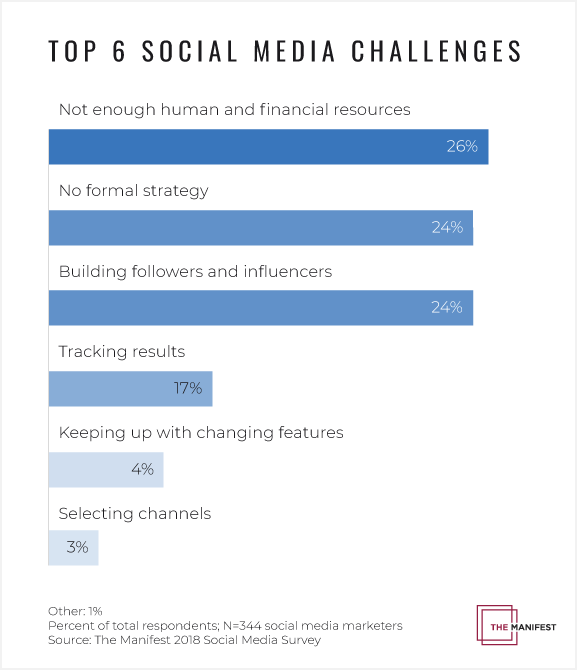
Use this report to learn about how companies overcome these top social media challenges.
Social Media Challenge #1: Not Enough Human and Financial Resources
The most common social media challenge businesses face is not having enough human and financial resources. More than one-quarter (26%) of social media marketers say this is their company’s biggest challenge when using social media.

For companies to succeed on social media, their leadership team needs to understand how important social media is as a marketing tool.
“I empathize with the marketers who can’t hit their goals or reach the potential of social media because they are limited by budget,” said Josh Krakauer, founder and CEO of social media marketing agency Sculpt. “But nothing replaces having a leadership team or decision-maker inside an organization who gets social media and is willing to put in long-term effort.”
A leader who understands the impact of social media and invests in long-term success can turn a lack of resources into just enough to get a company started with social media marketing.
Partner With Social Media Influencers
One way to overcome not having enough money and people to maintain your social media presence is to partner with influencers who can help promote your brand for you.
One Tribe Apparel, an e-commerce fashion brand that sells handmade clothes, bags, and yoga accessories from Thailand and donates $1 per sale to the Elephant Nature Park, struggled with a lack of resources.
“As a small business, this is our biggest hurdle,” said One Tribe Apparel Co-Founder Ryan O’Connor.
One Tribe Apparel overcomes its lack of financial and human resources by working with influencers, who spread the message about the company.
“These collaborations get us quality photos in unique locations without the cost of hiring a photographer, and they also help us gain followers by having the influencer talk about us and tag our account,” said O’Connor.
For example, One Tribe Apparel partnered with yoga instructor @cathymadeoyoga, who has an active Instagram account with more than 7,000 followers.

She helped promote One Tribe Apparel’s brand by tagging the company in a post: “… I’ve got a full day of teaching yoga today. What are you up to? Wearing @onetribeapparel.”
When influencers post about One Tribe Apparel, consumers gain awareness of the brand, and the brand gains more followers.
Share Social Media Responsibilities With Colleagues
Another way to make up for not having enough human and financial resources is to divide social media responsibilities among coworkers, like charter bus rental company GOGO Charters does.
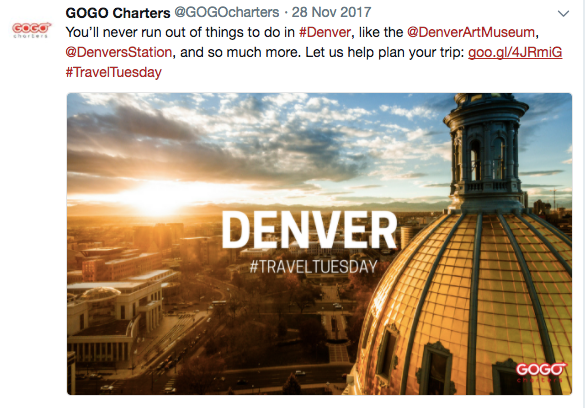
“There was no rhyme or reason to GOGO Charters’ social media content, and no one was tracking progress,” said Digital Content Producer Johnell Gibson. “Since we don’t have a dedicated social media team, it was difficult to find the time to put as much attention to our social media as it deserved.”
GOGO Charters overcame the problem by creating a social media plan that shares responsibility among multiple colleagues.
“Sharing the responsibility for our social presence prevents any one person from becoming overwhelmed with strategy and implementation,” said Gibson.
Multiple people working on GOGO’s social media accounts ensures that no one is overwhelmed, which allows employees to focus on social media in addition to other tasks.
If a company isn’t able to share social media duties among different colleagues, it can use social media management software, such as Buffer, TweetDeck, or Hootsuite.
“Many businesses do not have the capacity to have someone solely run their social media accounts,” said Smart Insights Social Media Executive Jessica Wade. “Use these free technologies, then spend assigned time per day answering users’ questions, resharing other content, and engaging with your followers.”
Companies that don’t have enough human resources can use social media software, which frees up time to perform social media tasks other than simply posting content.
Learn the best times to post to social media platforms.
Social Media Challenge #2: No Formal Social Media Strategy
Nearly one-quarter of companies (24%) struggle to refine social media efforts into a formal strategy.
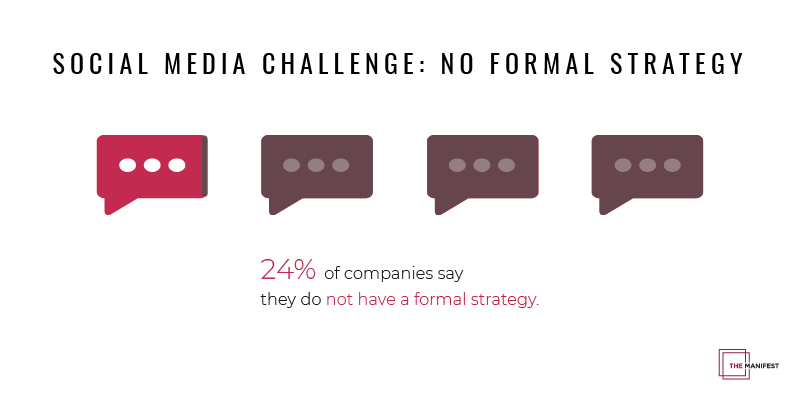
Companies should view social media as a formal marketing tool that requires a strategy.
“If you want great results on social media, you need to have a real strategy,” said Steve Pearson, CEO of Friendemic, a company that provides online reputation and social media software and services.
I’ve never heard a business owner say their 17-year old nephew is doing their website for them, but somehow, even in 2018, I still hear that about social media, and you should take these platforms seriously.
Some businesses believe social media doesn’t need to be taken seriously. But, in reality, you should have a formal strategy that includes:
- Business goals
- Audience and competitors
- Social media channels
- Content
- Resources
- Metrics for tracking success
Begin creating your social media strategy using our 6-step guide.
Choose the Right Social Media Platforms
Businesses without a formal social media strategy can benefit from choosing the platforms that will be most successful for their business.
Ambrosia Treatment Center, an addiction recovery center with locations in California, Florida, and New Jersey, focuses its social media strategy on the platforms the company find most successful.
“Without a strategy, social media is a waste of time,” said Marketing Director Michelle Kubot, who now works for JourneyPure, an addiction recovery center in Tennessee, Kentucky, and Florida. “You should understand what you’re trying to get out of social media. Why are you posting there? Is your target audience even there?”
At a former job, Kubot was asked to set up Pinterest and Instagram accounts for her company but found those platforms to be unsuccessful.
“There’s not a lot of value unless it matches your business’s audience and goals,” Kubot said. “We stayed focused on Facebook, which eventually became 9% of the total business.”
At Ambrosia Treatment Center, Kubot also found success on Facebook and posts a variety of content, from polls and videos to success stories and other articles.

Ambrosia Treatment Center’s Facebook strategy has paid off: It has more than 24,000 followers on Facebook – the third largest in its industry.
Learn how to choose the right social media platforms for your business.
Tailor a Strategy for Each Social Media Channel
Every social media channel is different, so some companies vary their strategy by platform.
For example, Quarks American Bento restaurant in St. Cloud, Minn., tailors its social media strategy for each platform.
“I think it’s important for entrepreneurs or small start-ups to pick a couple platforms to focus on first,” said Marketing Assistant Kim VanGilder. “It takes some time to develop a branded look or feel to your social media and to know the difference in what your social media is used for.”
Quarks varies its content on different social media platforms, such as Twitter, where it focuses on reaching out to other companies.
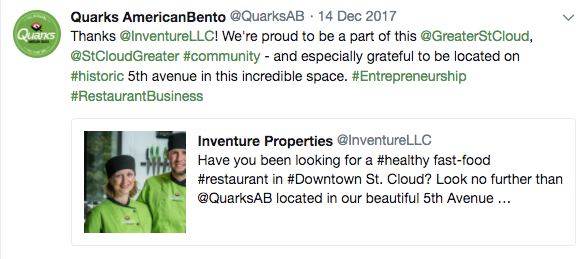
Varying its content on each platform helps Quarks create a social media strategy that makes sense for each channel.
Additional Reading: How to Set Up Social Media Profiles for Your Business
Social Media Challenge #3: Building a Community of Followers
Many businesses (24%) struggle with building a community of followers on social media.
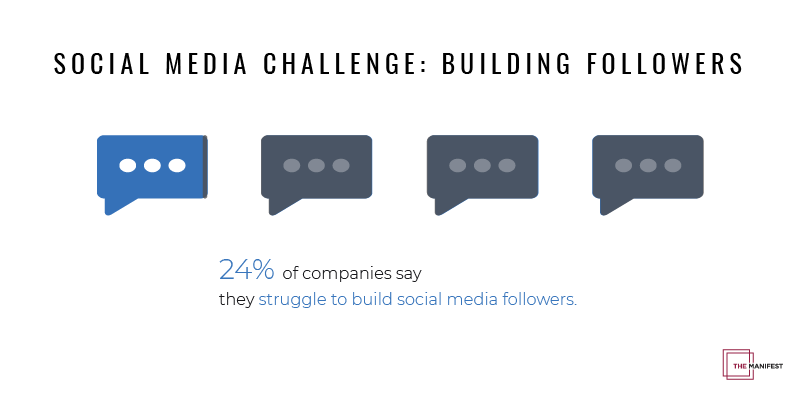
It is challenging for companies to build followers because social media platforms are filled with other businesses in the same industry.
“People have problems building followers because it’s a very crowded market now,” said Samuel, of Social Diva Media. “You can’t just be like everybody else. There has to be some value in your business to make you stand out.”
A business must be unique on social media to stand out, which can, in turn, grow more followers.
Build Followers In-Person
Companies that struggle to gain followers through online outreach can also promote their social pages in-person.
Magic show “Impossibilities – Magic, Mindreading, and Mayhem!” in Gatlinburg, Tenn., builds followers at its shows.
“Building followers can be difficult on certain platforms,” said “Impossibilities” performer and co-owner Erik Dobell. “We find most of our guests are on Facebook, so that’s where we focus a lot of our attention. You need to go where your audience is. To build followers, we let people know at our shows to follow us, and we interact with people who may be interested in our show on social media. It’s a slow grind, but it works.”
You need to go where your audience is.
To build followers, Dobell promotes the show’s Facebook account during performances and also interacts with potential and former customers on social media.

“Impossibilities” helps build engagement and followers by responding to comments and personalizing each message.
Test Different Content for Effectiveness
A company may find the most success with specific types of posts, such as videos, questions, or images.
West Coast Self-Storage in California, Oregon, and Washington, struggled with increasing its reach on social media.
“We’ve employed a trial-and-error approach to the types of posts we develop in order to see the effects on our reach numbers," said Internet Marketing Specialist Derek Hines. "We’ve found that posts that call for direct, yet simple, interactions have reached more followers.”
For example, one of West Coast Self-Storage’s most successful social media posts featured side-by-side images of two garages: one cluttered and one neat.

The simple question, “Which Garage Does Yours Look Like?” doubled West Coast Self-Storage’s normal reach numbers.
Read how to optimize your social media engagement strategy.
Social Media Challenge #4: Tracking Results
The fourth biggest social media challenge businesses face is tracking results, and 17% of companies say this is their biggest challenge.
![]()
Tracking results on social media can be a challenge because an impression may not lead to an immediate sale.
“Many businesses think of social media as a quick and easy way to gain sales because ‘everyone is on social,’” said Charlotte Chipperfield, CEO of social media marketing agency Chipperfield Media. “Sometimes, seeing something on social media can lead to a sale a few months later. Social media is a long game that involves investment in customer relationships.”
It may take time to gain conversions, but over time, companies can build relationships with potential customers on social media.
Focus on Long-Term Success
Success on social media isn’t always immediate.
For Detroit real estate agent Steven Edward, converting a sale from social media takes time and is a difficult metric to measure.

“A single post is not going to get you a sale or deal,” Edward said. “You must be active and persistent with your social media content. Social media is a great way to get in the door and introduce yourself, even though you haven’t physically met.”
Posting on social media may not result in an immediate sale, but potential customers remember your posts. When they’re in the market for your product or service, they may reach out to you because they have previously seen your company on social media.
“You can connect with people who you would never be able to connect with,” Edward said.
Social media allows companies to reach potential customers they otherwise wouldn’t be able to.
Track Only the Most Important Metrics
Some companies focus on only tracking the metrics they most value.
SmartBuyGlasses, an online glasses, contacts, and sunglasses retailer, has social media accounts on Facebook, Instagram, Twitter, LinkedIn, YouTube, Google+, and Pinterest.

SmartBuyGlasses has thousands of followers on most of its social media pages, but tracking the results of its social media efforts is sometimes difficult.
“While social media platforms make it easy to track paid social activities, like advertisements or boosted posts, it is very hard to measure the organic ROI (return on investments) of our posts,” said SmartBuyGlasses Social Media Coordinator Daniele Milani. “We overcame this by trying to simplify as much as possible, such as getting the bigger picture of some metrics such as traffic to the website. Then, if we notice a trend or a peak or something unexpected, we go into it on a more detailed level.”
With accounts on several social media platforms, SmartBuyGlasses focuses on tracking more large-scale metrics, like traffic to its website.
Common Social Media Challenges and Solutions
Below is a brief summary of the top social media challenges and how the businesses featured in this article overcame them.
| Problem | Solution #1 | Solution #2 |
|---|---|---|
| Not Enough Resources | Partner with influencers | Share social media responsibilities |
| No Formal Strategy | Choose the right platforms | Tailor strategy for each channel |
| Build Followers | Build followers in-person | Test different types of content |
| Track Results | Focus on long-term success | Track only the most important metrics |
Overcoming Social Media Challenges
Like every business endeavor, social media is filled with challenges, such as lack of resources, no strategy, building followers, and tracking results.
Despite these challenges, however, if the right effort is invested in social media, it can be a successful marketing tool.
About 52% of companies say social media helps increase their revenue and sales, and if a company works to overcome challenges, social media can help increase its revenue, too.
About the Survey
The Manifest surveyed 344 social media marketers from around the world at companies with more than 10 employees; the marketers’ companies are split evenly between B2B and B2C.
The majority of survey respondents are managers (38%), senior managers (22%), and associates (17%).
Most respondents are from the United Kingdom (30%), United States (22%), Australia (5%), India (5%), and Germany (3%).

